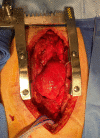Idiopathic Purulent Pericarditis Caused by Methicillin-Sensitive Staphylococcus Aureus in an Immunocompetent Adult
- PMID: 33936884
- PMCID: PMC8080989
- DOI: 10.7759/cureus.14173
Idiopathic Purulent Pericarditis Caused by Methicillin-Sensitive Staphylococcus Aureus in an Immunocompetent Adult
Abstract
Introduction: Acute purulent pericarditis is an exceedingly rare entity most often caused by direct intrathoracic contamination or hematogenous spread of a bacterial infection. Mortality nears 100% when left untreated. We present here a rare case of idiopathic bacterial pericarditis caused by methicillin-sensitive Staphylococcus aureus (MSSA).
Case: A 69-year-old male presented with chest pain and abdominal pain. He was found to have a pericardial effusion and tamponade and underwent emergent pericardiocentesis. Pericardial fluid culture grew methicillin-sensitive Staphylococcus aureus. The patient required multiple pericardial washouts and was then treated with four weeks of intravenous antibiotics.
Conclusion: While uncommon, clinical suspicion for purulent pericarditis should remain high due to the associated high mortality.
Keywords: bacterial pericarditis; purulent pericarditis.
Copyright © 2021, Huffman et al.
Conflict of interest statement
The authors have declared that no competing interests exist.
Figures





References
-
- Primary and secondary purulent pericarditis in otherwise healthy adults. Leoncini G, Iurilli L, Queirolo A, Catrambone G. Interact Cardiovasc Thorac Surg. 2006;5:652–654. - PubMed
-
- The changed spectrum of purulent pericarditis: an 86 year autopsy experience in 200 patients. Klacsmann PG, Bulkley BH, Hutchins GM. Am J Med. 1977;63:666–673. - PubMed
-
- Purulent pericarditis: review of a 20-year experience in a general hospital. Sagristà-Sauleda J, Barrabés JA, Permanyer-Miralda G, Soler-Soler J. J Am Coll Cardiol. 1993;15:1661–1665. - PubMed
-
- Guidelines on the diagnosis and management of pericardial diseases executive summary: the task force on the diagnosis and management of pericardial diseases of the European Society of Cardiology. Maisch B, Seferović PM, Ristić AD, et al. Eur Heart J. 2004;25:587–610. - PubMed
Publication types
LinkOut - more resources
Full Text Sources
Other Literature Sources
